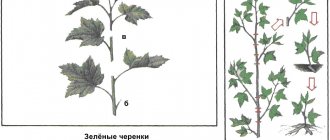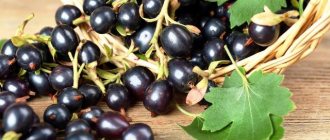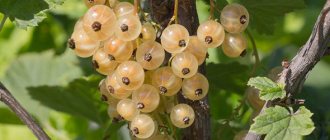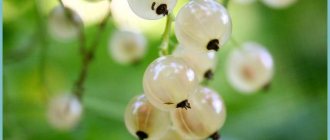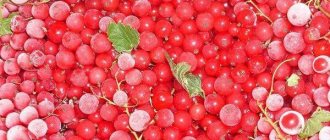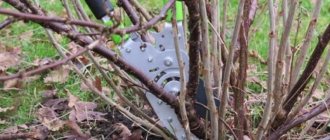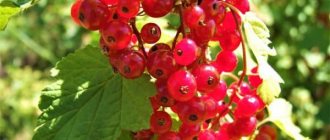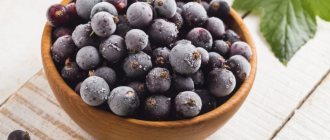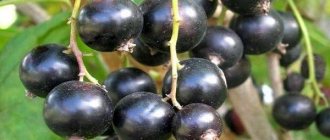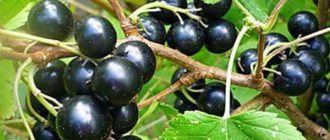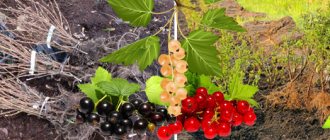When is it better to plant currants - in autumn or spring?
The optimal time for planting black currants is considered to be autumn . This is due to the fact that seedlings planted in autumn take root better. They manage to grow the root system and by spring they begin to bloom actively.
Let's consider the pros and cons of autumn planting currant bushes.
Planting in the fall has a number of advantages:
- The seedlings have time to get used to the new place, thanks to which they begin to actively develop in the spring.
- During this period there is a choice of a large number of seedlings.
- In autumn, plants require minimal care. At this time, they do not need large amounts of nutrients and moisture.
- There is no need for active fertilization.
- Adaptation to a permanent place is much better, and the stress of the transplant is easier to cope with.
But besides the positive aspects, there are also negative ones:
- There is a possibility that the plants will die from sudden frosts.
- Rodent attacks can damage the trunk of immature seedlings.
These are small shortcomings that can be resolved.
Optimal planting dates
The best time to plant currants in open ground depends on the climatic characteristics of a particular region. Also, many gardeners additionally use the lunar calendar to select the planting date.
Important! It is important to monitor weather forecasts before planting. It is necessary to allow a few more weeks before frost for the shrub to adapt.
Depending on the region
| Region | Optimal planting time |
| Southern regions | mid-October |
| Middle zone, Volga region, Moscow region | from the second half of September to the beginning of October |
| Leningrad region | early October |
| Ural, Siberia | second half of August |
These are indicative dates. First of all, you need to look at the weather . If the date is chosen correctly, the young bushes will take root better, and the mother plant will normally survive the cuttings.
Blackcurrant seedlings take root within 2-3 weeks. For red and white currants, this period can increase to a month.
According to the lunar calendar
The lunar calendar can be used as an additional tool to determine the timing of landings. The best periods are:
- September 27-29;
- first days of October;
- October 10-17;
- October 22-24 is pure.
According to the lunar calendar, you should not plant currants on days when there is a full or new moon. There is a risk that the plants will not take root. At this time, it is better to start putting things in order on the site.
Beneficial properties of white currants
The berries of this garden crop contain many useful substances and vitamins. In addition to fats, proteins and carbohydrates, the fruits are saturated with dietary fiber, fiber, pectin, beta-carotene, mono- and disaccharides, ash, vitamins A, C, E, P, as well as vitamin B, B1 (thiamine), B2 (riboflavin ), B6 (pyridoxine), B9 (folic acid).
White currant fruits are rich in potassium, phosphorus, calcium, magnesium, sodium and iron.
The calorie content of berries is about 43 kcal per 100g.
The pulp of this berry crop contains:
- Vitamin A, which improves immunity and cellular metabolism, and also helps prevent the formation of tumors;
- Vitamin C is an essential element for fighting colds;
- Vitamin P – cleanses blood vessels and improves blood composition; the combination of this vitamin with ascorbic acid reduces the risk of atherosclerosis;
- Vitamin E significantly slows down the aging process.
How to plant currants in autumn
Proper landing has many nuances, so it requires quality preparation. For normal fruiting, it is necessary to prepare the seedlings, choose a location and make a planting hole.
Selection and preparation of seedlings
If the seedlings are of high quality, they will take root well and begin to produce a good harvest. It is necessary not only to choose healthy planting material, but also to prepare it for planting.
When choosing, you need to pay attention to the following points:
- The root system should have healthy shoots, including 3-5 lignified skeletal roots. Their length is about 20 cm.
- The seedling should have 2-3 healthy above-ground shoots 30-40 cm long.
- They show no signs of disease or damage.
- There are living buds on the stem.
When choosing a currant variety, it is necessary to take into account that it is suitable for the growing region.
If planting material has already been purchased, but planting had to be postponed for a certain period of time, then it must be stored by wrapping the root system with a wet rag. The top is wrapped with plastic film. This will prevent the roots from drying out.
The best varieties of white currants
White currant, being a close relative of red and black, has a number of features. White currant differs from other varieties not only in color, but also in its ability to help treat diseases associated with increased blood clotting, especially for older people. The berries contain less ascorbic acid than other types, so they can be consumed by people with high stomach acidity. The best varieties of white currant are described below.
"Versailles"
It is the most popular variety in Russia and has an average fruit ripening period. The shrub is small, spreading.
“Versailles” differs from other varieties in its large berries with a diameter of 1.1 cm and a weight of one berry of 0.75 g. Productivity is high. The plant is medium winter-hardy.
It is important to know! The Versailles white currant variety is not susceptible to the spread of powdery mildew.
"White Potapenko"
The variety, which has a mid-early ripening period, is characterized by good resistance to low temperatures. Berries of this type have a pleasant taste.
The plant is of medium height, with semi-spreading branches. The weight of one berry is from 0.5 g. Early ripening variety.
The main advantage of this variety is that “Belaya Potapenko” tolerates frost well, since it was bred specifically for cultivation in Siberia.
"Belyana"
The berries of this variety have an average ripening period. The variety was bred in Siberia. The plant is medium in size, with semi-spreading branches. The fruits are large, the weight of one berry is about 1.5 grams, and they ripen together. "Belyana" is not susceptible to the spread of powdery mildew, but can become a victim of anthracnose. The fruits are not suitable for transportation. Advantages – self-fertility and the variety has good yield.
"Dutch White"
A mid-early white currant variety that tolerates low temperatures well. The fruits of this variety are large and round. The plant is small and irregular in shape. The main advantages of "Dutch White" are high productivity, self-fertility, and resistance to anthracnose disease. The variety is easily propagated by cuttings and has good yield.
"Primus"
The variety was bred in the Czech Republic. The berries have a mid-season ripening period. The weight of one berry is from 1 gram; you can collect up to 10 kg of white currants from a bush. The shrub is not afraid of frost, and is also not susceptible to infection by powdery mildew, anthracnose and gall aphids.
All varieties of white currant have both advantages and disadvantages. Some varieties have high yields, but are susceptible to the spread of diseases. Others, on the contrary, have strong immunity, but bear significantly less fruit. It is rare to find varieties that combine both disease resistance and high yield. When choosing currant seedlings, it is best to rely on your own needs and carefully inspect the cuttings before purchasing.
Methods for planting currants
Gardeners use three main planting methods: fan, trellis, and classic (single planting in a hole).
Fan method
For seedlings, they make not holes, but a trench.
Its width should be about 40 cm, and the length depends on the number of seedlings and the size of the plot. The bushes are placed 1 m from each other. The shoots are spread over a low trellis in the shape of a fan. This method of planting allows plants to develop better. Typically, bushes planted using the fan method are almost 2 times larger than other plants. Productivity also increases, but this method requires additional effort in tying up the shoots.
Vertical planting under a trellis
This method differs from the previous method in the method of creating a trench. It is dug to a depth of 20 cm. The width should be approximately 15 cm. After this, fertilizers are poured into the trench, and the remaining free space is covered with earth.
The bed is covered with a dense film (dark agrofibre), in which cross-shaped cuts 30 cm wide are made. Through them, seedlings or cuttings are planted to a depth of 7 cm. Then, as they grow, the currant branches are tied to a trellis.
Classic way
This method is recommended for use when there is a small amount of planting material, and also when it is not possible to make trellises.
The holes are prepared and filled with nutrient substrate. Seedlings are planted at an angle of 45 degrees to the surface of the earth. Productivity will increase in the next 3 years.
Features of planting different types
Depending on the type of currant, there are certain planting nuances. They should be taken into account in order to obtain a high-quality and abundant harvest.
Black and golden currants
Black and golden currants grow well only on fertile, loose and moist soils. It does not tolerate wet or dry places.
Groundwater should be no closer than 70 cm to the surface of the earth. If the soil is acidic, then dolomite flour or lime is added to it. Otherwise, the plants will develop poorly and often get sick.
Important! Blackcurrant bushes are optimally planted to a depth of 10 cm.
Black currants require sufficient sun . Shaded places depress the plant, cause leaves to fall and reduce yield. The berries gradually become sour and small.
In the southern regions, the crop is planted in lowlands, as moisture is better retained there. But it is necessary that it does not accumulate there. These are moisture-loving plants, but they do not tolerate stagnant water .
Golden currants can be planted in shaded areas. It grows poorly on almost all soils except clayey ones.
White and red currants
White and red currants do not have the same requirements as black currants. To plant, it is enough to deepen the seedlings by 6-8 cm.
Features of choosing a planting site for colored currants:
- It can be planted on dry and not very fertile soils.
- White and red currants do not tolerate acidic and waterlogged soils.
- Requires good lighting.
- It is preferable to plant on slightly alkaline soils.
Botanical description
White currant is a close relative of such bushes as red currant, gooseberry and black currant. The white currant bush usually grows in height up to one and a half meters, although sometimes it can reach 2.5 m. The structure of white currant is very similar to red: the leaves of white currant are three-lobed, usually serrated along the edge, with a darker upper side of the plate. The flowers are small, with yellowish or greenish petals, collected in brushes - bloom in May. The fruits of white currants of different shades of white and yellow flowers with a diameter of 6-10 cm are spherical in shape and form clusters.
In terms of taste, white currant berries differ from black currant fruits and lack its strong, recognizable aroma, but they have almost the same taste as red currant fruits. White currants bear fruit in July.
We will tell you how to plant and care for white currants, how white and black currants differ from each other, how to prune white currants, what gooseberry diseases and pests are dangerous for white currants, whether white currants can be grown in the Moscow region, and we will also offer a description of the varieties white currants for the southern regions and the Moscow region.
- Caring for gooseberries after harvest
How to propagate currants from a bush
There are several ways to propagate currants from a bush. This is a fairly simple procedure, but requires careful attention. We'll look at how to plant blackcurrants below.
By layering
Layers begin to be harvested in spring. To do this, you need to choose a two-year-old healthy shoot that is located close to the ground. It is deepened into the ground by 10-15 cm. This place is first fertilized.
About 30 cm of shoot should remain on the surface of the ground. To better keep the branch in the soil, it can be secured with a hook made of thick wire or a special bracket.
Throughout the summer, the shoot must be watered. By the end of September, 2-4 new shoots should appear and a root system should form. After this, the cuttings are transplanted.
Green or woody cuttings
Currants are cut by dividing a healthy shoot into several parts. To do this, use sharp pruning shears, which must be pre-disinfected.
The length of the cutting should be 20 cm. A straight cut is made from the top, and an oblique cut from the bottom. An oblique cut allows for a larger surface area, which increases the chances of the cutting taking root. Carrying out the work in mid-September.
Soil for growing currants
Currants are demanding on soil fertility. Loamy and sandy loam soils, medium in mechanical composition, with a high humus content, and loose soils are more suitable for it. Very light and heavy clay soils are undesirable. The foundation is important; it must allow water to pass through, but at the same time retain it, so the best soil is loam. Sand is unsuitable as a base, because it does not retain water, and clay, which retains its excess. In acidic soils, roots rot, seedlings develop poorly, and yields are low. Such soils should be limed.
Caring for bushes after planting
After autumn planting, proper care of currants is required. It is as follows:
- Trimming. The main task of the seedling is to build a powerful root system in order not to freeze during winter frosts. The development of the above-ground part in this case will only be harmful, so it is cut off by two-thirds.
- Be sure to mulch the beds. The minimum layer thickness should be 3 cm. Compost, peat or humus are suitable as mulch.
- All holes must be sprinkled with sand so that after watering a crust does not appear on the ground.
- If autumn is dry, regular watering . You only need to water with warm water.
- Before the arrival of frost, the plantings are hilled up to 15 cm.
With the arrival of spring, the layer of hilled earth should be removed. This will stimulate the growth of currants.
Tips for Beginner Gardeners
There are certain recommendations that will be useful not only for novice gardeners, but also for experienced specialists:
- When planting several bushes, it is advisable to place them in one place, rather than plant them throughout the area. This will help retain moisture in the soil and improve the quality of the crop.
- Pruning is performed not only in spring, but also in autumn.
- To prevent the plant from freezing during the winter cold, the bed should be covered with black plastic film. This will retain heat and promote condensation.
- Plants should be watered as the soil dries out. Black currants require the most frequent watering.
Possible mistakes
During planting, many inexperienced gardeners make simple mistakes. The most common are:
- Planting is done too early or too late.
- Poor quality planting material was purchased.
- Too dense planting of bushes.
- After planting, the recommended pruning is not carried out. This is one of the main conditions for the normal development of plants.
